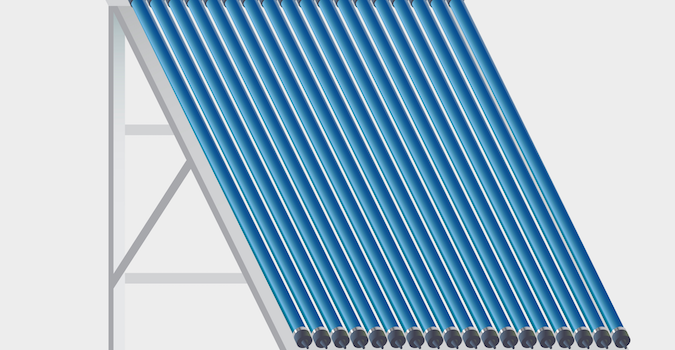
How do thermodynamic panels work?
Thermodynamic panels absorb heat from the atmosphere and use it to heat your home, in a similar way to ground source heat pumps. The panels circulate liquid coolant, which extracts heat from the air around it and turns it into gas. This gas then passes through a compressor, which boosts its temperature until it is warm enough to heat water.
The technology hinges on the temperature variation between the coolant and the air around it. Because the refrigerant circulating around the panel is a very low temperature of between -20°C and -30°C, it can even absorb relative warmth from the air on cold days.
Like solar PV and solar thermal systems, thermodynamic panels are are normally installed on a roof (or a wall). This means they can look more discreet than bulky heat pumps.
How hot is the water produced by thermodynamic panels?
The water produced is a maximum temperature of 55ºC, so it can be used for showers, swimming pools, or to supplement central heating. Thermodynamic systems have a built-in immersion heater that occasionally spikes the water temperature to 70ºC, killing off bacteria such as Legionella.
Do thermodynamic panels work in any weather?
In theory, thermodynamic panels should work in all weather conditions, unlike solar PV or solar thermal systems. The panels should still produce hot water in windy, wet or cold weather.
If positioned in the right place, they can benefit from some solar gain, but the panels are designed to work without it. The location you choose for your panels is therefore not as vital as it is with other renewables such as solar and wind.
How much do thermodynamic panels cost?
Each panel costs a hefty £5000 to buy and install. Most manufacturers suggest that one or two panels will be enough to heat sanitary water for a family of four.
Thermodynamic panels do not qualify for the Renewable Heat Incentive, a government scheme which gives quarterly payments to installers of renewable heating technologies. The fact the Government have not backed the technology suggest a lack of faith in the benefits of the technology for householders.
This aside, the technology should be able to pay for itself in order to be worthwhile. The payback period of something with such high installation costs could be pretty long.
Something else to take into account is that thermodynamic panels are not ‘free’ to run, as some manufacturers claim. The compressor runs on electricity, costing £8 to £10 per month for a domestic system.
Benefits
- Less bulky than ground source heat pumps, as no fans required.
- Source of clean energy.
- Not weather-dependent.
Limitations
- Expensive to install.
- Not 100% renewable – compressor runs off electricity.
Cost
- Each panel costs £5000 to buy and install.
- Electricity for the compressor costs £8 to £10 per month for a domestic system.











Magic box costs are 20% less than advertised here